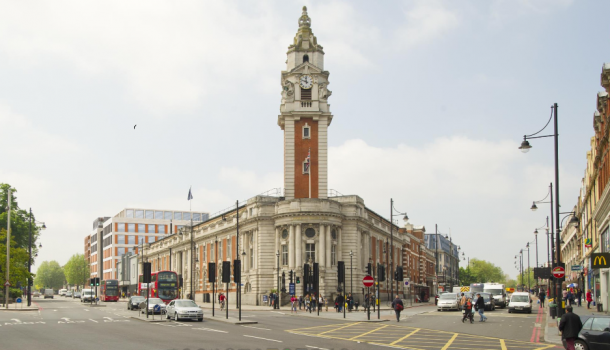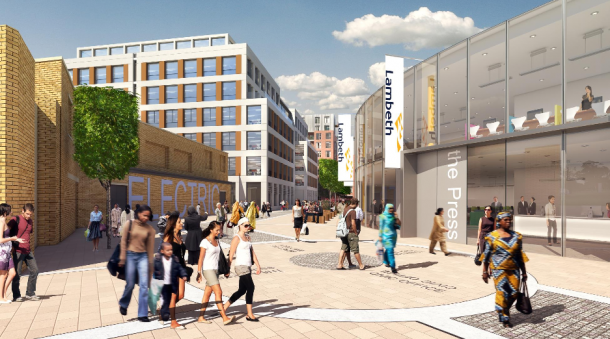
Lambeth council has named it preferred developer in a scheme to demolish council offices and build 275 new homes and an enterprise centre around the existing town hall.
A meeting of the council’s Cabinet made the decision at a meeting at the town hall last night (November 4) , naming applicants Muse as their preferred development partner.

Last month councillors and officers were slammed by residents, and the Brixton Society, for failing to properly ask for the views of Brixton people over bids by three developers to transform the town hall area.
The council said the overall scheme would save £4.5million in council running costs and would be cost neutral to the borough. It also said it aims to secure 40% of the new homes as “affordable”.
Cabinet member for finance Paul McGlone added: “Lambeth town hall is an iconic building that’s been at the heart of the community for over 100 years and this development makes sure it retains that special place.”
The winning development firm is one of three organisations which unveiled their proposals last month. View the proposals from Muse here.
More reaction to follow.
What do you make of the plans and the consultation? Leave your comments below.










[…] residents have expressed doubts about the appointment of Muse as the preferred developer of the new ‘town hall campus’ in a scheme that will see council-owned buildings replaced by […]
I don’t know the full details of this project, but it does seem strange that the council are knocking down Olive Morris after only just doing it up a few years ago. I also noticed they are redoing all the pavements in the area. Is this really a good use of council funds? Agree with the earlier comment, put the money into improving schools.
The only possible conclusion to draw from this is that the council has FAR too much money to throw around. Olive Morris “Customer Centre” was only done up a few years ago anyway—now it is to be knocked down? What really ought to happen to Lambeth Council is this—sack 3/4 of the staff and spend the money saved, along with the money earmarked for this appalling scheme, on NEW SCHOOLS.
There is just no way this scheme is going to produce 40% affordable housing. The council papers say they will ‘aspire’ to the target, it does not commit, and at this stage they should know what they can get.
If the council doesn’t manage to get 40% affordable on its own land it will only serve to demonstrate how they are just not serious about building affordable housing in the borough. Just like in Vauxhall where the council signs away development rights on schemes with little affordable housing every day.
One of my friends was at the presentations at the Ritzy. He said that Kajima were proposing development of Olive Morris House and Wanless Road as were all the bidders. Apparently Kajima’s proposals for those sites were slightly lower density, and all the affordable was Social rented.
I can’t see how Muse will get Planning Consent for their designs as shown. It’s massive overdevelopment on each site. I also think their ideas for the Town Hall are a missed opportunity. The Kajima designs show a much more radical rethink of that building, which is probably why their design for the new offices looks less dominant than the Muse design.
Like the council – too big and totally lacking imagination.
Maybe Kajima were not ambitious enough. Their scheme did not seem to involve redeveloping Olive Morris House and Wanless Road. The key to this decision is surely financial engineering rather than architecture and the use of space.
There was a lack of clarity in the cabinet meeting as to whether the MUSE scheme will produce the supposed Lambeth policy norm of 40% affordable homes. Indeed the opposition claimed it would only produce 20% affordable. The available public documentation does not deal with this issue – and “Yellow Paper” confidential documents obviously not available for public scrutiny.
The impression I obtained as a member of the public at cabinet yesterday evening was that this was a more genteel version of Prime Ministers Question Time. The leader of the opposition derided the current administration’s office accommodation strategy and insisted that the council could not meet its own policy on affordable housing (i.e. 40% – predicting it would be 20%) and moreover the scheme had spun out of control financial, since the cost had risen from £25 million to £50 million in the 4 years the project had been under discussion. The leader of the council brushed this aside and asserted that the coalition government was causing major problems for the council by swingeing funding cuts, including top-slicing Lambeth council funding to pay towards the Mayor of London’s expenditure.
On a piquant note Councillor Sally Prentice mentioned that she was often asked why Lambeth did not have a borough museum. It is a shame that the grand coalition council in 1994-98 dismantled the “Red Room” in the Town Hall basement. Had this shrine to the ultra-left been retained in tact, we would have had a “museum of struggle”. Workers were Workers then – when not on strike or picketing duty of course. It would have been a fabulous nostalgic tourist attraction for Lambeth Town Hall!
I thought Kajima scheme was much better for how it treated Porden Road and the public spaces
http://futurebrixton.files.wordpress.com/2013/10/20131001-kajima-2013-10-01-sw2-ec-isft-co-production-presentation_16x9-final-low-res1.pdf